HSN719: Assessing Nutrition, Activity, and Anthropometry Techniques
VerifiedAdded on 2023/04/21
|31
|8965
|204
Report
AI Summary
This report evaluates methods used to assess nutrient intake and physical activity in young to middle-aged women, comparing results with Australian Physical Activity guidelines. The study involved female students who completed a 3-day food record, a food frequency questionnaire (FFQ), and a 3-day physical activity diary. The results indicated that fat intake was higher than recommended, while calcium and iron intakes were below the Estimated Average Requirement (EAR). Energy expenditure measured by the Active Australia Survey (AAS) differed significantly from the 3-day diary method. Body fat percentages measured by skinfolds were higher than those measured by Bioelectrical Impedance Analysis (BIA). The report concludes that determining the suitability of diets is complex and further research is needed to explore ways to assess female dietary fitness. Desklib provides access to similar reports and study resources for students.
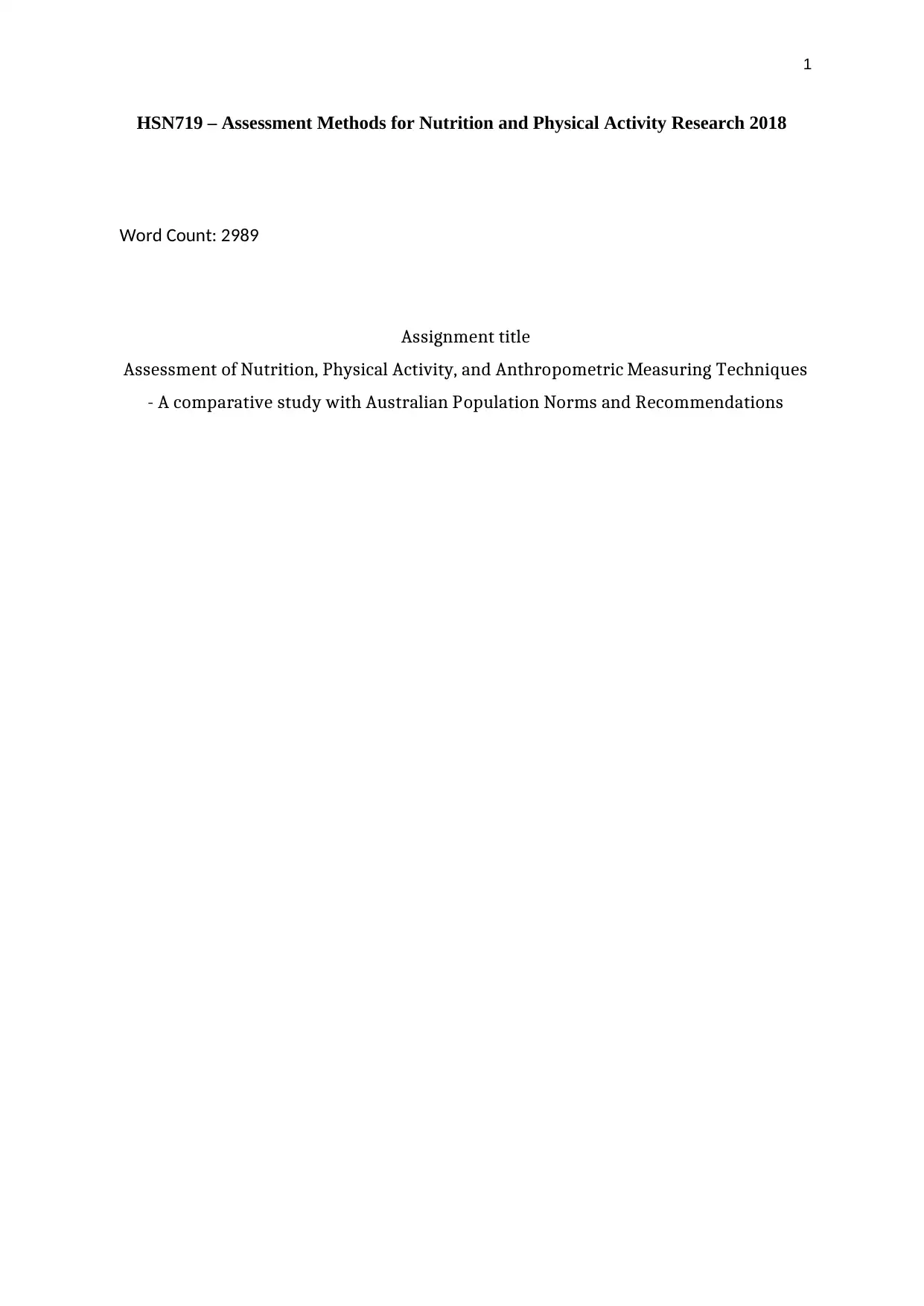
1
HSN719 – Assessment Methods for Nutrition and Physical Activity Research 2018
Word Count: 2989
Assignment title
Assessment of Nutrition, Physical Activity, and Anthropometric Measuring Techniques
- A comparative study with Australian Population Norms and Recommendations
HSN719 – Assessment Methods for Nutrition and Physical Activity Research 2018
Word Count: 2989
Assignment title
Assessment of Nutrition, Physical Activity, and Anthropometric Measuring Techniques
- A comparative study with Australian Population Norms and Recommendations
Paraphrase This Document
Need a fresh take? Get an instant paraphrase of this document with our AI Paraphraser

2
Abstract
Purpose: The primary aim of this review was to evaluate the method used (3DD) to assess
the nutrients intake and physical activity measures for modern and middle-aged youth with
the PA guidelines of Australia. Methods: Throughout the study, healthy female students of
the third year enrolled in HSN305 course took place. 173 students of 18 years and over were
selected. A set of parallel messages were collected using 3-day daily food records. FFQ was
developed to evaluate the usual dietary habits as well as nutrients. 3-Day Physical Activity
Diary was used to measure Physical activity of the participants. From the Schofield equation,
basic metabolic rate was calculated. Results: Energy intake from fat was comparatively
higher than the other two nutrients. 95% of participants were in absorbing nutrients from fat
oriented food. 91% of participants were found to abide by the recommended percentage
intake of nutrients from protein oriented food. The comparative analysis yielded that calcium
and iron intakes by the participants were well below the EAR cut points. It reflects a
significant difference between the calcium intake measured by FFQ and 3DFR methods.
Energy expenditure measured in AAS scale was significantly higher than the measure by
3DD. The correlation by Pearson for 156 female participants reflected an almost zero
Correlation between them. There was a statistically significant difference in fat measured by
the two methods, and percentage fat measured by skinfolds was significantly higher than that
of the measures of the BIA method. Conclusion: The interpretation of the suitability of the
feed ration is complex and varies according to the average level, depending on the percentage
of participants in the relevant PA-directives or the statistical probability of insufficient
evaluation. There is a need to explore further ways to determine the fitness of females’ diets.
Abstract
Purpose: The primary aim of this review was to evaluate the method used (3DD) to assess
the nutrients intake and physical activity measures for modern and middle-aged youth with
the PA guidelines of Australia. Methods: Throughout the study, healthy female students of
the third year enrolled in HSN305 course took place. 173 students of 18 years and over were
selected. A set of parallel messages were collected using 3-day daily food records. FFQ was
developed to evaluate the usual dietary habits as well as nutrients. 3-Day Physical Activity
Diary was used to measure Physical activity of the participants. From the Schofield equation,
basic metabolic rate was calculated. Results: Energy intake from fat was comparatively
higher than the other two nutrients. 95% of participants were in absorbing nutrients from fat
oriented food. 91% of participants were found to abide by the recommended percentage
intake of nutrients from protein oriented food. The comparative analysis yielded that calcium
and iron intakes by the participants were well below the EAR cut points. It reflects a
significant difference between the calcium intake measured by FFQ and 3DFR methods.
Energy expenditure measured in AAS scale was significantly higher than the measure by
3DD. The correlation by Pearson for 156 female participants reflected an almost zero
Correlation between them. There was a statistically significant difference in fat measured by
the two methods, and percentage fat measured by skinfolds was significantly higher than that
of the measures of the BIA method. Conclusion: The interpretation of the suitability of the
feed ration is complex and varies according to the average level, depending on the percentage
of participants in the relevant PA-directives or the statistical probability of insufficient
evaluation. There is a need to explore further ways to determine the fitness of females’ diets.

3
Table of Contents
Abstract......................................................................................................................................2
Introduction................................................................................................................................3
Research Objective/ Aim........................................................................................................5
Participants and Methods...........................................................................................................6
Subjects...................................................................................................................................6
Measurement Instruments.......................................................................................................6
Nutritional Consumption Measures.....................................................................................6
Physical Activity Measures.................................................................................................6
Anthropometric Measures...................................................................................................7
Statistical Methods..............................................................................................................7
Results........................................................................................................................................8
Dietary intake..........................................................................................................................8
Physical Activity...................................................................................................................12
Anthropometric Characteristics............................................................................................13
Discussion................................................................................................................................16
Findings....................................................................................................................................16
Dietary intake....................................................................................................................16
Physical activity.................................................................................................................16
Anthropometric characteristics..........................................................................................16
Limitations............................................................................................................................17
Conclusion................................................................................................................................17
Future Research....................................................................................................................17
References................................................................................................................................18
Appendices...............................................................................................................................20
Practical Data...........................................................................................................................22
Table of Contents
Abstract......................................................................................................................................2
Introduction................................................................................................................................3
Research Objective/ Aim........................................................................................................5
Participants and Methods...........................................................................................................6
Subjects...................................................................................................................................6
Measurement Instruments.......................................................................................................6
Nutritional Consumption Measures.....................................................................................6
Physical Activity Measures.................................................................................................6
Anthropometric Measures...................................................................................................7
Statistical Methods..............................................................................................................7
Results........................................................................................................................................8
Dietary intake..........................................................................................................................8
Physical Activity...................................................................................................................12
Anthropometric Characteristics............................................................................................13
Discussion................................................................................................................................16
Findings....................................................................................................................................16
Dietary intake....................................................................................................................16
Physical activity.................................................................................................................16
Anthropometric characteristics..........................................................................................16
Limitations............................................................................................................................17
Conclusion................................................................................................................................17
Future Research....................................................................................................................17
References................................................................................................................................18
Appendices...............................................................................................................................20
Practical Data...........................................................................................................................22
⊘ This is a preview!⊘
Do you want full access?
Subscribe today to unlock all pages.

Trusted by 1+ million students worldwide
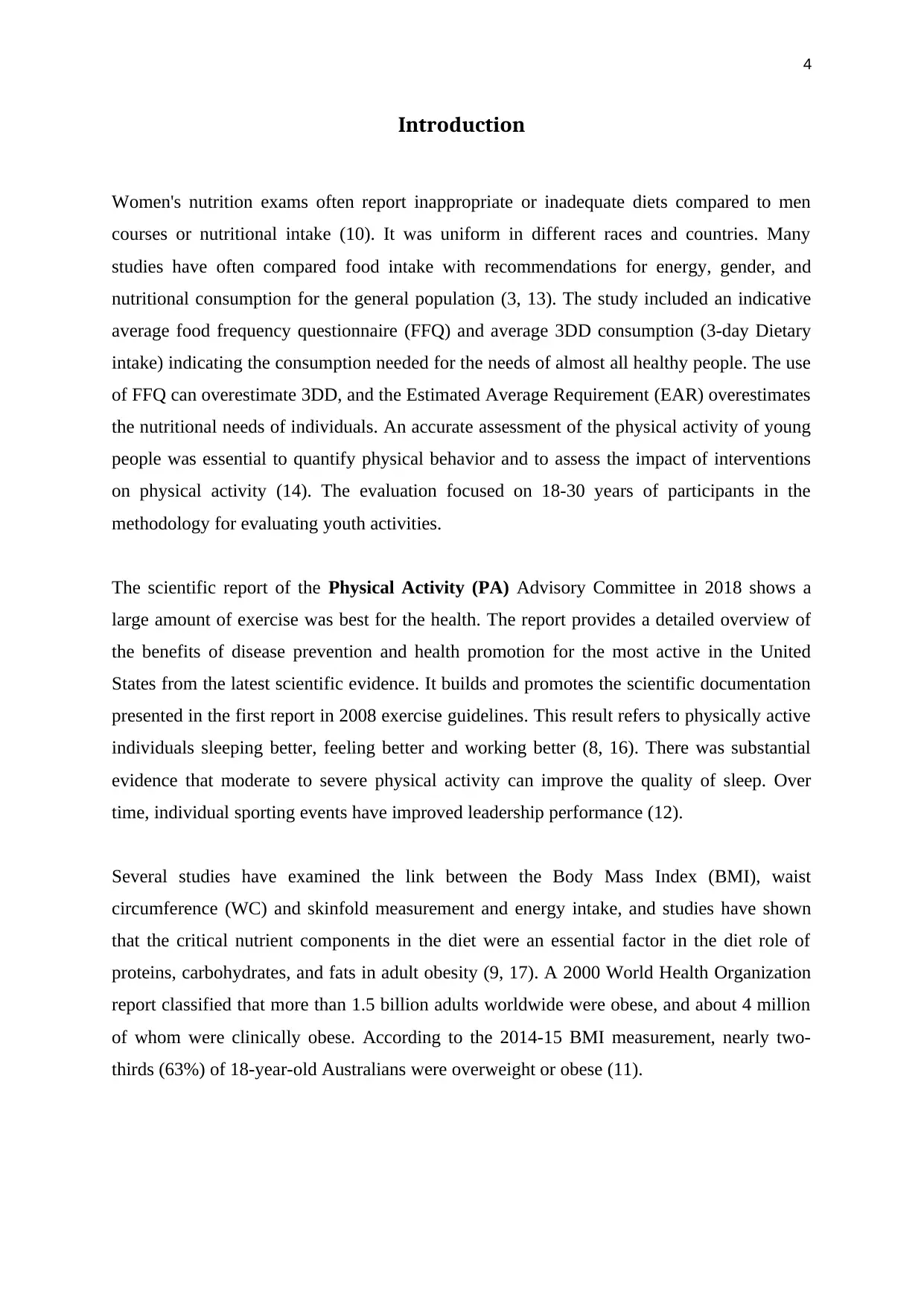
4
Introduction
Women's nutrition exams often report inappropriate or inadequate diets compared to men
courses or nutritional intake (10). It was uniform in different races and countries. Many
studies have often compared food intake with recommendations for energy, gender, and
nutritional consumption for the general population (3, 13). The study included an indicative
average food frequency questionnaire (FFQ) and average 3DD consumption (3-day Dietary
intake) indicating the consumption needed for the needs of almost all healthy people. The use
of FFQ can overestimate 3DD, and the Estimated Average Requirement (EAR) overestimates
the nutritional needs of individuals. An accurate assessment of the physical activity of young
people was essential to quantify physical behavior and to assess the impact of interventions
on physical activity (14). The evaluation focused on 18-30 years of participants in the
methodology for evaluating youth activities.
The scientific report of the Physical Activity (PA) Advisory Committee in 2018 shows a
large amount of exercise was best for the health. The report provides a detailed overview of
the benefits of disease prevention and health promotion for the most active in the United
States from the latest scientific evidence. It builds and promotes the scientific documentation
presented in the first report in 2008 exercise guidelines. This result refers to physically active
individuals sleeping better, feeling better and working better (8, 16). There was substantial
evidence that moderate to severe physical activity can improve the quality of sleep. Over
time, individual sporting events have improved leadership performance (12).
Several studies have examined the link between the Body Mass Index (BMI), waist
circumference (WC) and skinfold measurement and energy intake, and studies have shown
that the critical nutrient components in the diet were an essential factor in the diet role of
proteins, carbohydrates, and fats in adult obesity (9, 17). A 2000 World Health Organization
report classified that more than 1.5 billion adults worldwide were obese, and about 4 million
of whom were clinically obese. According to the 2014-15 BMI measurement, nearly two-
thirds (63%) of 18-year-old Australians were overweight or obese (11).
Introduction
Women's nutrition exams often report inappropriate or inadequate diets compared to men
courses or nutritional intake (10). It was uniform in different races and countries. Many
studies have often compared food intake with recommendations for energy, gender, and
nutritional consumption for the general population (3, 13). The study included an indicative
average food frequency questionnaire (FFQ) and average 3DD consumption (3-day Dietary
intake) indicating the consumption needed for the needs of almost all healthy people. The use
of FFQ can overestimate 3DD, and the Estimated Average Requirement (EAR) overestimates
the nutritional needs of individuals. An accurate assessment of the physical activity of young
people was essential to quantify physical behavior and to assess the impact of interventions
on physical activity (14). The evaluation focused on 18-30 years of participants in the
methodology for evaluating youth activities.
The scientific report of the Physical Activity (PA) Advisory Committee in 2018 shows a
large amount of exercise was best for the health. The report provides a detailed overview of
the benefits of disease prevention and health promotion for the most active in the United
States from the latest scientific evidence. It builds and promotes the scientific documentation
presented in the first report in 2008 exercise guidelines. This result refers to physically active
individuals sleeping better, feeling better and working better (8, 16). There was substantial
evidence that moderate to severe physical activity can improve the quality of sleep. Over
time, individual sporting events have improved leadership performance (12).
Several studies have examined the link between the Body Mass Index (BMI), waist
circumference (WC) and skinfold measurement and energy intake, and studies have shown
that the critical nutrient components in the diet were an essential factor in the diet role of
proteins, carbohydrates, and fats in adult obesity (9, 17). A 2000 World Health Organization
report classified that more than 1.5 billion adults worldwide were obese, and about 4 million
of whom were clinically obese. According to the 2014-15 BMI measurement, nearly two-
thirds (63%) of 18-year-old Australians were overweight or obese (11).
Paraphrase This Document
Need a fresh take? Get an instant paraphrase of this document with our AI Paraphraser
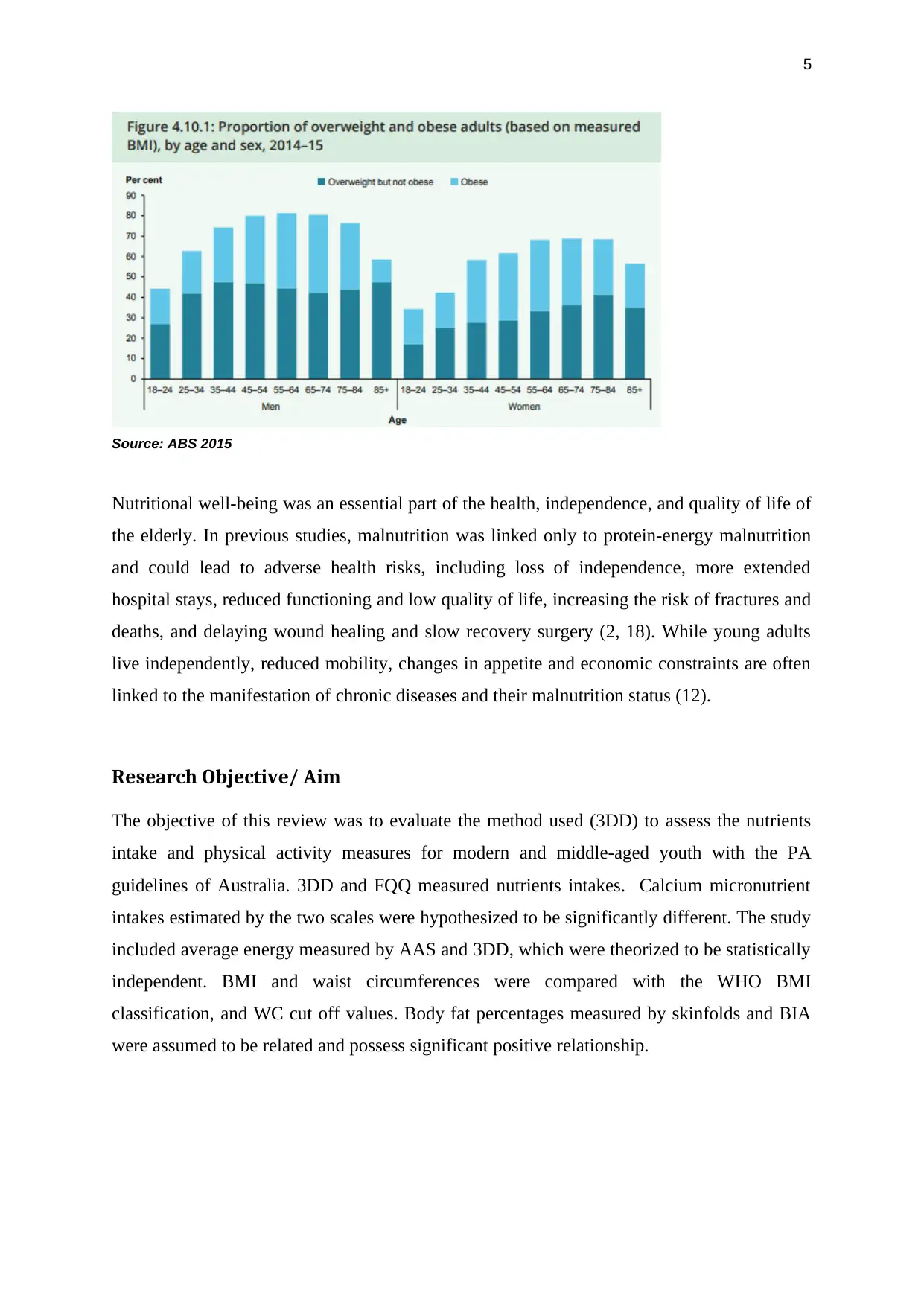
5
Source: ABS 2015
Nutritional well-being was an essential part of the health, independence, and quality of life of
the elderly. In previous studies, malnutrition was linked only to protein-energy malnutrition
and could lead to adverse health risks, including loss of independence, more extended
hospital stays, reduced functioning and low quality of life, increasing the risk of fractures and
deaths, and delaying wound healing and slow recovery surgery (2, 18). While young adults
live independently, reduced mobility, changes in appetite and economic constraints are often
linked to the manifestation of chronic diseases and their malnutrition status (12).
Research Objective/ Aim
The objective of this review was to evaluate the method used (3DD) to assess the nutrients
intake and physical activity measures for modern and middle-aged youth with the PA
guidelines of Australia. 3DD and FQQ measured nutrients intakes. Calcium micronutrient
intakes estimated by the two scales were hypothesized to be significantly different. The study
included average energy measured by AAS and 3DD, which were theorized to be statistically
independent. BMI and waist circumferences were compared with the WHO BMI
classification, and WC cut off values. Body fat percentages measured by skinfolds and BIA
were assumed to be related and possess significant positive relationship.
Source: ABS 2015
Nutritional well-being was an essential part of the health, independence, and quality of life of
the elderly. In previous studies, malnutrition was linked only to protein-energy malnutrition
and could lead to adverse health risks, including loss of independence, more extended
hospital stays, reduced functioning and low quality of life, increasing the risk of fractures and
deaths, and delaying wound healing and slow recovery surgery (2, 18). While young adults
live independently, reduced mobility, changes in appetite and economic constraints are often
linked to the manifestation of chronic diseases and their malnutrition status (12).
Research Objective/ Aim
The objective of this review was to evaluate the method used (3DD) to assess the nutrients
intake and physical activity measures for modern and middle-aged youth with the PA
guidelines of Australia. 3DD and FQQ measured nutrients intakes. Calcium micronutrient
intakes estimated by the two scales were hypothesized to be significantly different. The study
included average energy measured by AAS and 3DD, which were theorized to be statistically
independent. BMI and waist circumferences were compared with the WHO BMI
classification, and WC cut off values. Body fat percentages measured by skinfolds and BIA
were assumed to be related and possess significant positive relationship.
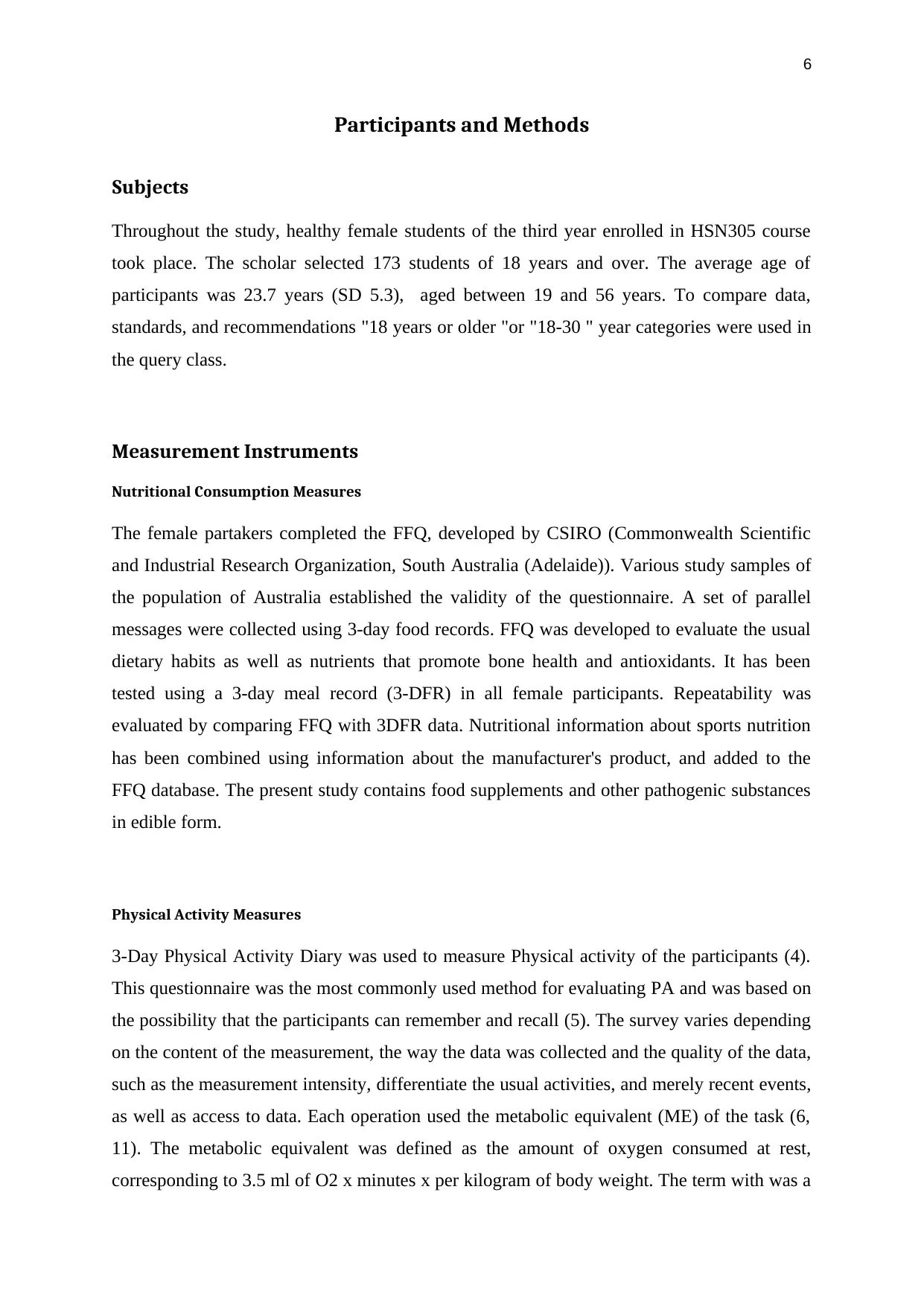
6
Participants and Methods
Subjects
Throughout the study, healthy female students of the third year enrolled in HSN305 course
took place. The scholar selected 173 students of 18 years and over. The average age of
participants was 23.7 years (SD 5.3), aged between 19 and 56 years. To compare data,
standards, and recommendations "18 years or older "or "18-30 " year categories were used in
the query class.
Measurement Instruments
Nutritional Consumption Measures
The female partakers completed the FFQ, developed by CSIRO (Commonwealth Scientific
and Industrial Research Organization, South Australia (Adelaide)). Various study samples of
the population of Australia established the validity of the questionnaire. A set of parallel
messages were collected using 3-day food records. FFQ was developed to evaluate the usual
dietary habits as well as nutrients that promote bone health and antioxidants. It has been
tested using a 3-day meal record (3-DFR) in all female participants. Repeatability was
evaluated by comparing FFQ with 3DFR data. Nutritional information about sports nutrition
has been combined using information about the manufacturer's product, and added to the
FFQ database. The present study contains food supplements and other pathogenic substances
in edible form.
Physical Activity Measures
3-Day Physical Activity Diary was used to measure Physical activity of the participants (4).
This questionnaire was the most commonly used method for evaluating PA and was based on
the possibility that the participants can remember and recall (5). The survey varies depending
on the content of the measurement, the way the data was collected and the quality of the data,
such as the measurement intensity, differentiate the usual activities, and merely recent events,
as well as access to data. Each operation used the metabolic equivalent (ME) of the task (6,
11). The metabolic equivalent was defined as the amount of oxygen consumed at rest,
corresponding to 3.5 ml of O2 x minutes x per kilogram of body weight. The term with was a
Participants and Methods
Subjects
Throughout the study, healthy female students of the third year enrolled in HSN305 course
took place. The scholar selected 173 students of 18 years and over. The average age of
participants was 23.7 years (SD 5.3), aged between 19 and 56 years. To compare data,
standards, and recommendations "18 years or older "or "18-30 " year categories were used in
the query class.
Measurement Instruments
Nutritional Consumption Measures
The female partakers completed the FFQ, developed by CSIRO (Commonwealth Scientific
and Industrial Research Organization, South Australia (Adelaide)). Various study samples of
the population of Australia established the validity of the questionnaire. A set of parallel
messages were collected using 3-day food records. FFQ was developed to evaluate the usual
dietary habits as well as nutrients that promote bone health and antioxidants. It has been
tested using a 3-day meal record (3-DFR) in all female participants. Repeatability was
evaluated by comparing FFQ with 3DFR data. Nutritional information about sports nutrition
has been combined using information about the manufacturer's product, and added to the
FFQ database. The present study contains food supplements and other pathogenic substances
in edible form.
Physical Activity Measures
3-Day Physical Activity Diary was used to measure Physical activity of the participants (4).
This questionnaire was the most commonly used method for evaluating PA and was based on
the possibility that the participants can remember and recall (5). The survey varies depending
on the content of the measurement, the way the data was collected and the quality of the data,
such as the measurement intensity, differentiate the usual activities, and merely recent events,
as well as access to data. Each operation used the metabolic equivalent (ME) of the task (6,
11). The metabolic equivalent was defined as the amount of oxygen consumed at rest,
corresponding to 3.5 ml of O2 x minutes x per kilogram of body weight. The term with was a
⊘ This is a preview!⊘
Do you want full access?
Subscribe today to unlock all pages.

Trusted by 1+ million students worldwide
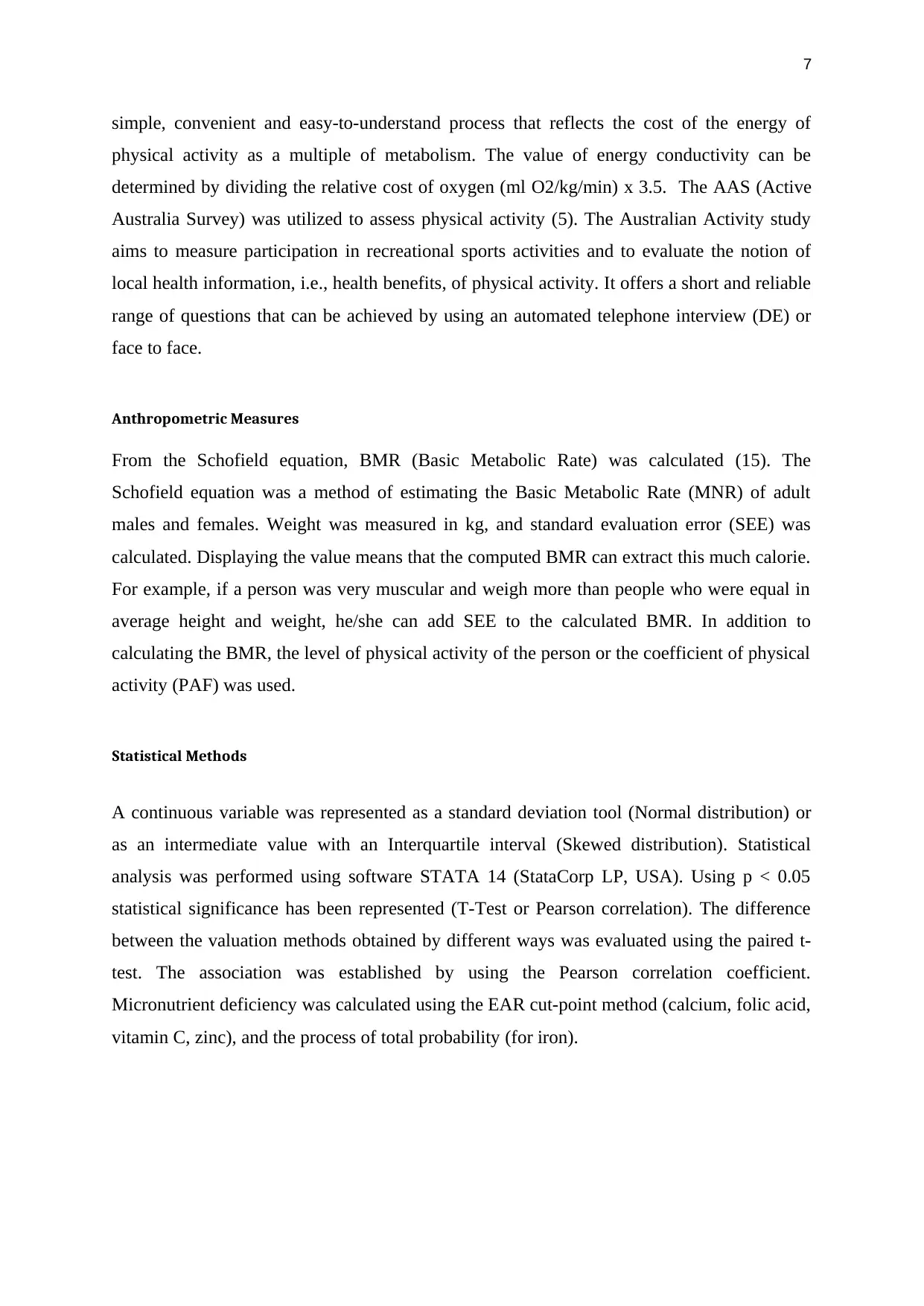
7
simple, convenient and easy-to-understand process that reflects the cost of the energy of
physical activity as a multiple of metabolism. The value of energy conductivity can be
determined by dividing the relative cost of oxygen (ml O2/kg/min) x 3.5. The AAS (Active
Australia Survey) was utilized to assess physical activity (5). The Australian Activity study
aims to measure participation in recreational sports activities and to evaluate the notion of
local health information, i.e., health benefits, of physical activity. It offers a short and reliable
range of questions that can be achieved by using an automated telephone interview (DE) or
face to face.
Anthropometric Measures
From the Schofield equation, BMR (Basic Metabolic Rate) was calculated (15). The
Schofield equation was a method of estimating the Basic Metabolic Rate (MNR) of adult
males and females. Weight was measured in kg, and standard evaluation error (SEE) was
calculated. Displaying the value means that the computed BMR can extract this much calorie.
For example, if a person was very muscular and weigh more than people who were equal in
average height and weight, he/she can add SEE to the calculated BMR. In addition to
calculating the BMR, the level of physical activity of the person or the coefficient of physical
activity (PAF) was used.
Statistical Methods
A continuous variable was represented as a standard deviation tool (Normal distribution) or
as an intermediate value with an Interquartile interval (Skewed distribution). Statistical
analysis was performed using software STATA 14 (StataCorp LP, USA). Using p < 0.05
statistical significance has been represented (T-Test or Pearson correlation). The difference
between the valuation methods obtained by different ways was evaluated using the paired t-
test. The association was established by using the Pearson correlation coefficient.
Micronutrient deficiency was calculated using the EAR cut-point method (calcium, folic acid,
vitamin C, zinc), and the process of total probability (for iron).
simple, convenient and easy-to-understand process that reflects the cost of the energy of
physical activity as a multiple of metabolism. The value of energy conductivity can be
determined by dividing the relative cost of oxygen (ml O2/kg/min) x 3.5. The AAS (Active
Australia Survey) was utilized to assess physical activity (5). The Australian Activity study
aims to measure participation in recreational sports activities and to evaluate the notion of
local health information, i.e., health benefits, of physical activity. It offers a short and reliable
range of questions that can be achieved by using an automated telephone interview (DE) or
face to face.
Anthropometric Measures
From the Schofield equation, BMR (Basic Metabolic Rate) was calculated (15). The
Schofield equation was a method of estimating the Basic Metabolic Rate (MNR) of adult
males and females. Weight was measured in kg, and standard evaluation error (SEE) was
calculated. Displaying the value means that the computed BMR can extract this much calorie.
For example, if a person was very muscular and weigh more than people who were equal in
average height and weight, he/she can add SEE to the calculated BMR. In addition to
calculating the BMR, the level of physical activity of the person or the coefficient of physical
activity (PAF) was used.
Statistical Methods
A continuous variable was represented as a standard deviation tool (Normal distribution) or
as an intermediate value with an Interquartile interval (Skewed distribution). Statistical
analysis was performed using software STATA 14 (StataCorp LP, USA). Using p < 0.05
statistical significance has been represented (T-Test or Pearson correlation). The difference
between the valuation methods obtained by different ways was evaluated using the paired t-
test. The association was established by using the Pearson correlation coefficient.
Micronutrient deficiency was calculated using the EAR cut-point method (calcium, folic acid,
vitamin C, zinc), and the process of total probability (for iron).
Paraphrase This Document
Need a fresh take? Get an instant paraphrase of this document with our AI Paraphraser
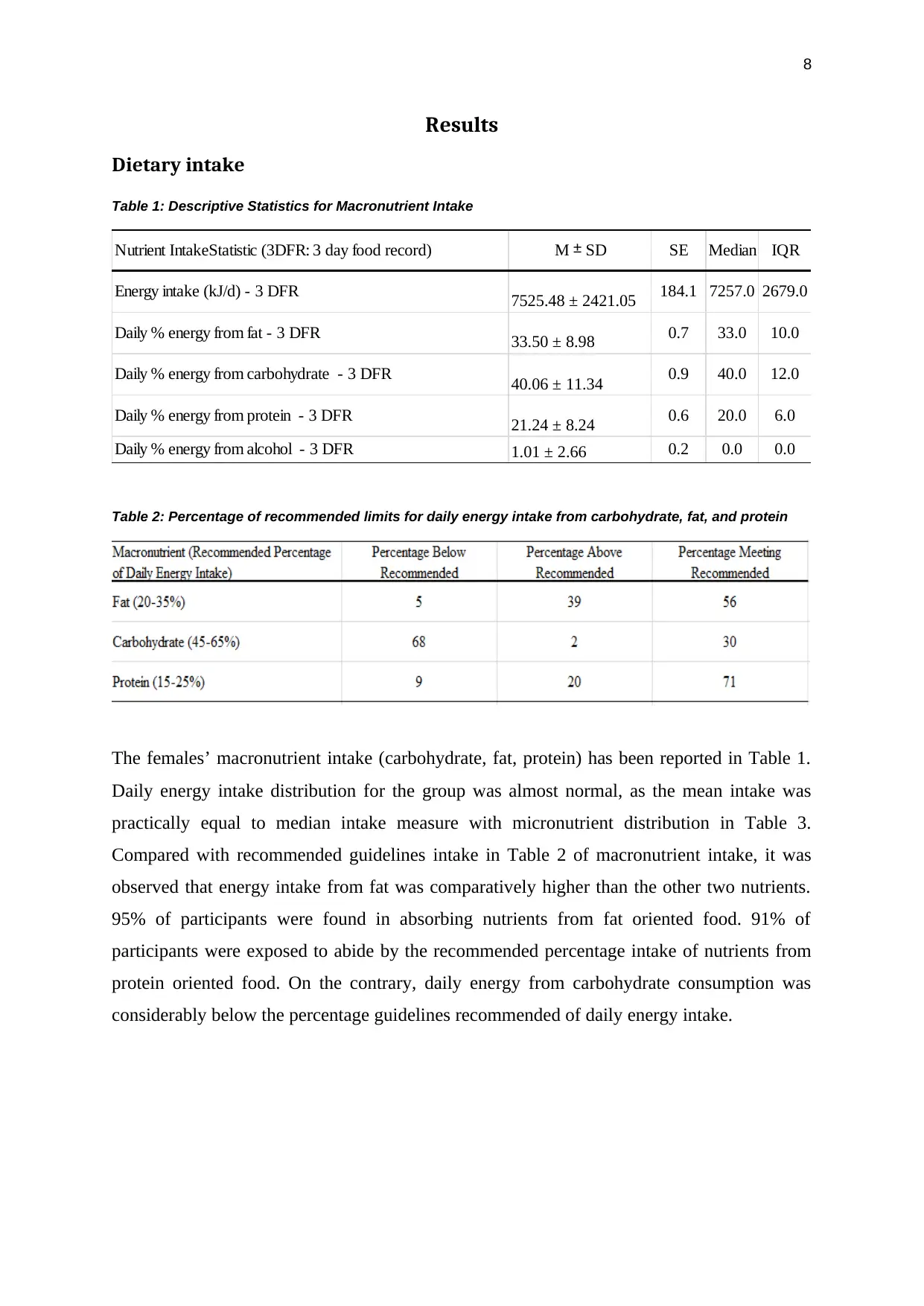
8
Results
Dietary intake
Table 1: Descriptive Statistics for Macronutrient Intake
Nutrient IntakeStatistic (3DFR: 3 day food record) M ± SD SE Median IQR
Energy intake (kJ/d) - 3 DFR 7525.48 ± 2421.05 184.1 7257.0 2679.0
Daily % energy from fat - 3 DFR 33.50 ± 8.98 0.7 33.0 10.0
Daily % energy from carbohydrate - 3 DFR 40.06 ± 11.34 0.9 40.0 12.0
Daily % energy from protein - 3 DFR 21.24 ± 8.24 0.6 20.0 6.0
Daily % energy from alcohol - 3 DFR 1.01 ± 2.66 0.2 0.0 0.0
Table 2: Percentage of recommended limits for daily energy intake from carbohydrate, fat, and protein
The females’ macronutrient intake (carbohydrate, fat, protein) has been reported in Table 1.
Daily energy intake distribution for the group was almost normal, as the mean intake was
practically equal to median intake measure with micronutrient distribution in Table 3.
Compared with recommended guidelines intake in Table 2 of macronutrient intake, it was
observed that energy intake from fat was comparatively higher than the other two nutrients.
95% of participants were found in absorbing nutrients from fat oriented food. 91% of
participants were exposed to abide by the recommended percentage intake of nutrients from
protein oriented food. On the contrary, daily energy from carbohydrate consumption was
considerably below the percentage guidelines recommended of daily energy intake.
Results
Dietary intake
Table 1: Descriptive Statistics for Macronutrient Intake
Nutrient IntakeStatistic (3DFR: 3 day food record) M ± SD SE Median IQR
Energy intake (kJ/d) - 3 DFR 7525.48 ± 2421.05 184.1 7257.0 2679.0
Daily % energy from fat - 3 DFR 33.50 ± 8.98 0.7 33.0 10.0
Daily % energy from carbohydrate - 3 DFR 40.06 ± 11.34 0.9 40.0 12.0
Daily % energy from protein - 3 DFR 21.24 ± 8.24 0.6 20.0 6.0
Daily % energy from alcohol - 3 DFR 1.01 ± 2.66 0.2 0.0 0.0
Table 2: Percentage of recommended limits for daily energy intake from carbohydrate, fat, and protein
The females’ macronutrient intake (carbohydrate, fat, protein) has been reported in Table 1.
Daily energy intake distribution for the group was almost normal, as the mean intake was
practically equal to median intake measure with micronutrient distribution in Table 3.
Compared with recommended guidelines intake in Table 2 of macronutrient intake, it was
observed that energy intake from fat was comparatively higher than the other two nutrients.
95% of participants were found in absorbing nutrients from fat oriented food. 91% of
participants were exposed to abide by the recommended percentage intake of nutrients from
protein oriented food. On the contrary, daily energy from carbohydrate consumption was
considerably below the percentage guidelines recommended of daily energy intake.
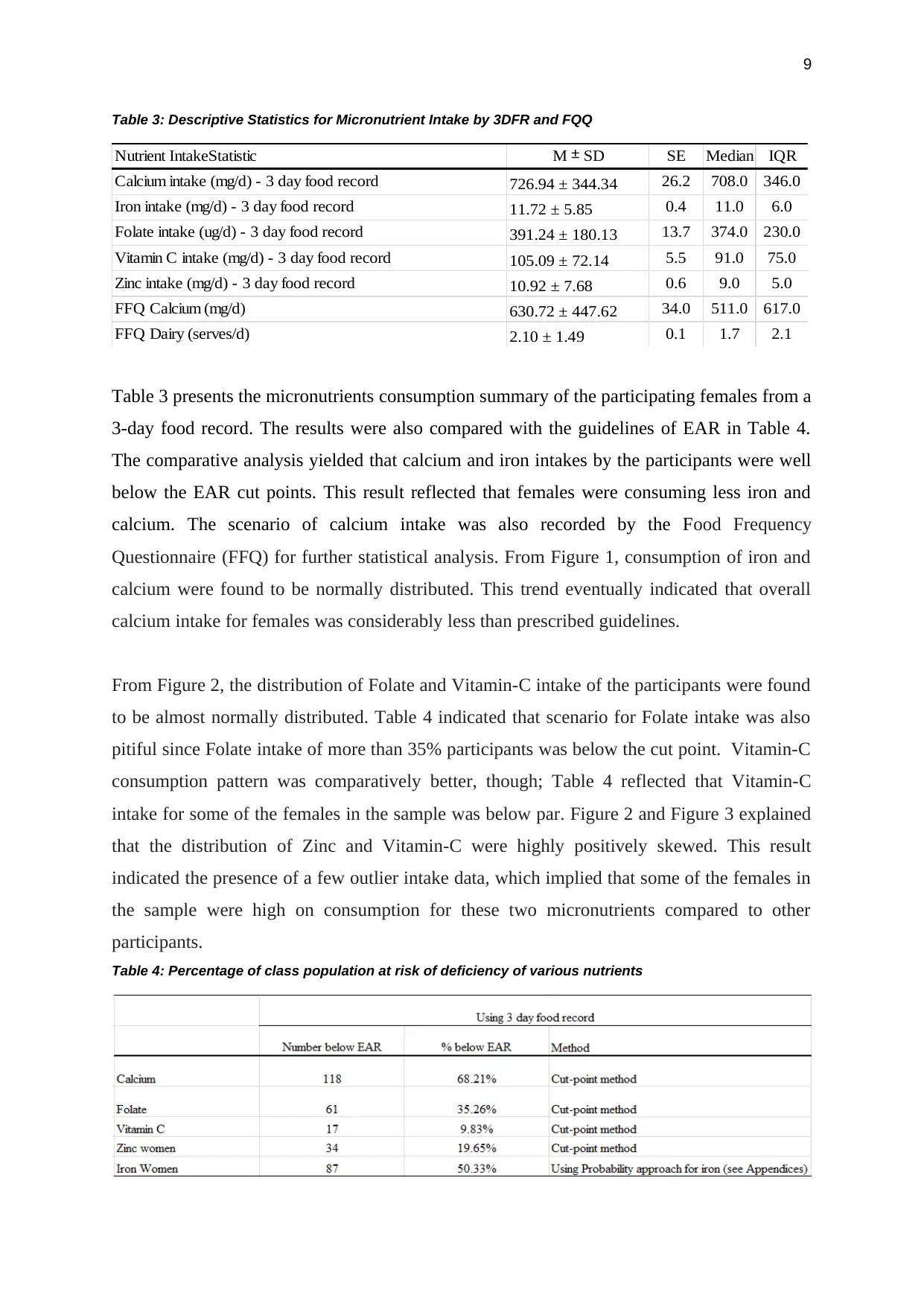
9
Table 3: Descriptive Statistics for Micronutrient Intake by 3DFR and FQQ
Nutrient IntakeStatistic M ± SD SE Median IQR
Calcium intake (mg/d) - 3 day food record 726.94 ± 344.34 26.2 708.0 346.0
Iron intake (mg/d) - 3 day food record 11.72 ± 5.85 0.4 11.0 6.0
Folate intake (ug/d) - 3 day food record 391.24 ± 180.13 13.7 374.0 230.0
Vitamin C intake (mg/d) - 3 day food record 105.09 ± 72.14 5.5 91.0 75.0
Zinc intake (mg/d) - 3 day food record 10.92 ± 7.68 0.6 9.0 5.0
FFQ Calcium (mg/d) 630.72 ± 447.62 34.0 511.0 617.0
FFQ Dairy (serves/d) 2.10 ± 1.49 0.1 1.7 2.1
Table 3 presents the micronutrients consumption summary of the participating females from a
3-day food record. The results were also compared with the guidelines of EAR in Table 4.
The comparative analysis yielded that calcium and iron intakes by the participants were well
below the EAR cut points. This result reflected that females were consuming less iron and
calcium. The scenario of calcium intake was also recorded by the Food Frequency
Questionnaire (FFQ) for further statistical analysis. From Figure 1, consumption of iron and
calcium were found to be normally distributed. This trend eventually indicated that overall
calcium intake for females was considerably less than prescribed guidelines.
From Figure 2, the distribution of Folate and Vitamin-C intake of the participants were found
to be almost normally distributed. Table 4 indicated that scenario for Folate intake was also
pitiful since Folate intake of more than 35% participants was below the cut point. Vitamin-C
consumption pattern was comparatively better, though; Table 4 reflected that Vitamin-C
intake for some of the females in the sample was below par. Figure 2 and Figure 3 explained
that the distribution of Zinc and Vitamin-C were highly positively skewed. This result
indicated the presence of a few outlier intake data, which implied that some of the females in
the sample were high on consumption for these two micronutrients compared to other
participants.
Table 4: Percentage of class population at risk of deficiency of various nutrients
Table 3: Descriptive Statistics for Micronutrient Intake by 3DFR and FQQ
Nutrient IntakeStatistic M ± SD SE Median IQR
Calcium intake (mg/d) - 3 day food record 726.94 ± 344.34 26.2 708.0 346.0
Iron intake (mg/d) - 3 day food record 11.72 ± 5.85 0.4 11.0 6.0
Folate intake (ug/d) - 3 day food record 391.24 ± 180.13 13.7 374.0 230.0
Vitamin C intake (mg/d) - 3 day food record 105.09 ± 72.14 5.5 91.0 75.0
Zinc intake (mg/d) - 3 day food record 10.92 ± 7.68 0.6 9.0 5.0
FFQ Calcium (mg/d) 630.72 ± 447.62 34.0 511.0 617.0
FFQ Dairy (serves/d) 2.10 ± 1.49 0.1 1.7 2.1
Table 3 presents the micronutrients consumption summary of the participating females from a
3-day food record. The results were also compared with the guidelines of EAR in Table 4.
The comparative analysis yielded that calcium and iron intakes by the participants were well
below the EAR cut points. This result reflected that females were consuming less iron and
calcium. The scenario of calcium intake was also recorded by the Food Frequency
Questionnaire (FFQ) for further statistical analysis. From Figure 1, consumption of iron and
calcium were found to be normally distributed. This trend eventually indicated that overall
calcium intake for females was considerably less than prescribed guidelines.
From Figure 2, the distribution of Folate and Vitamin-C intake of the participants were found
to be almost normally distributed. Table 4 indicated that scenario for Folate intake was also
pitiful since Folate intake of more than 35% participants was below the cut point. Vitamin-C
consumption pattern was comparatively better, though; Table 4 reflected that Vitamin-C
intake for some of the females in the sample was below par. Figure 2 and Figure 3 explained
that the distribution of Zinc and Vitamin-C were highly positively skewed. This result
indicated the presence of a few outlier intake data, which implied that some of the females in
the sample were high on consumption for these two micronutrients compared to other
participants.
Table 4: Percentage of class population at risk of deficiency of various nutrients
⊘ This is a preview!⊘
Do you want full access?
Subscribe today to unlock all pages.

Trusted by 1+ million students worldwide
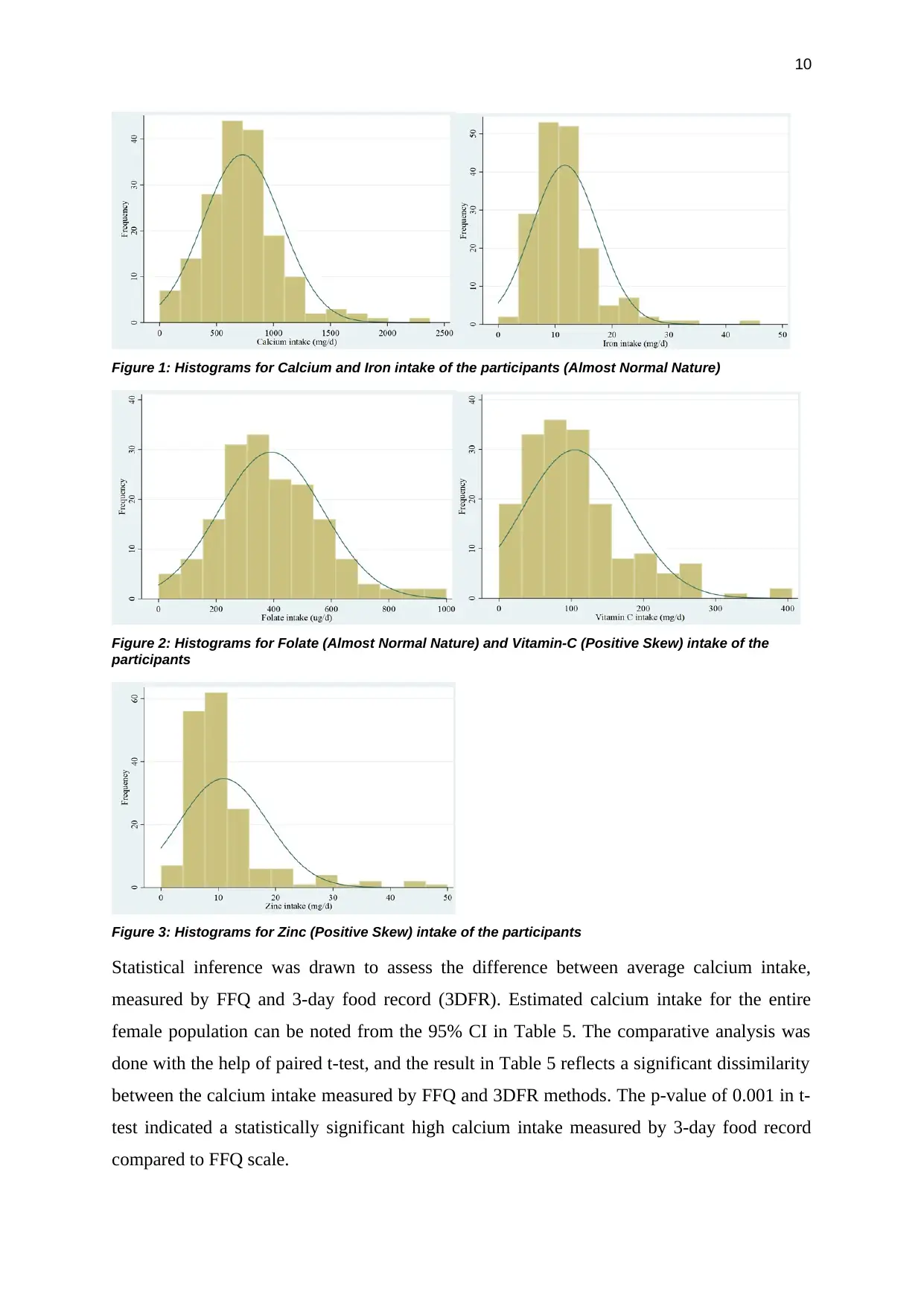
10
Figure 1: Histograms for Calcium and Iron intake of the participants (Almost Normal Nature)
Figure 2: Histograms for Folate (Almost Normal Nature) and Vitamin-C (Positive Skew) intake of the
participants
Figure 3: Histograms for Zinc (Positive Skew) intake of the participants
Statistical inference was drawn to assess the difference between average calcium intake,
measured by FFQ and 3-day food record (3DFR). Estimated calcium intake for the entire
female population can be noted from the 95% CI in Table 5. The comparative analysis was
done with the help of paired t-test, and the result in Table 5 reflects a significant dissimilarity
between the calcium intake measured by FFQ and 3DFR methods. The p-value of 0.001 in t-
test indicated a statistically significant high calcium intake measured by 3-day food record
compared to FFQ scale.
Figure 1: Histograms for Calcium and Iron intake of the participants (Almost Normal Nature)
Figure 2: Histograms for Folate (Almost Normal Nature) and Vitamin-C (Positive Skew) intake of the
participants
Figure 3: Histograms for Zinc (Positive Skew) intake of the participants
Statistical inference was drawn to assess the difference between average calcium intake,
measured by FFQ and 3-day food record (3DFR). Estimated calcium intake for the entire
female population can be noted from the 95% CI in Table 5. The comparative analysis was
done with the help of paired t-test, and the result in Table 5 reflects a significant dissimilarity
between the calcium intake measured by FFQ and 3DFR methods. The p-value of 0.001 in t-
test indicated a statistically significant high calcium intake measured by 3-day food record
compared to FFQ scale.
Paraphrase This Document
Need a fresh take? Get an instant paraphrase of this document with our AI Paraphraser
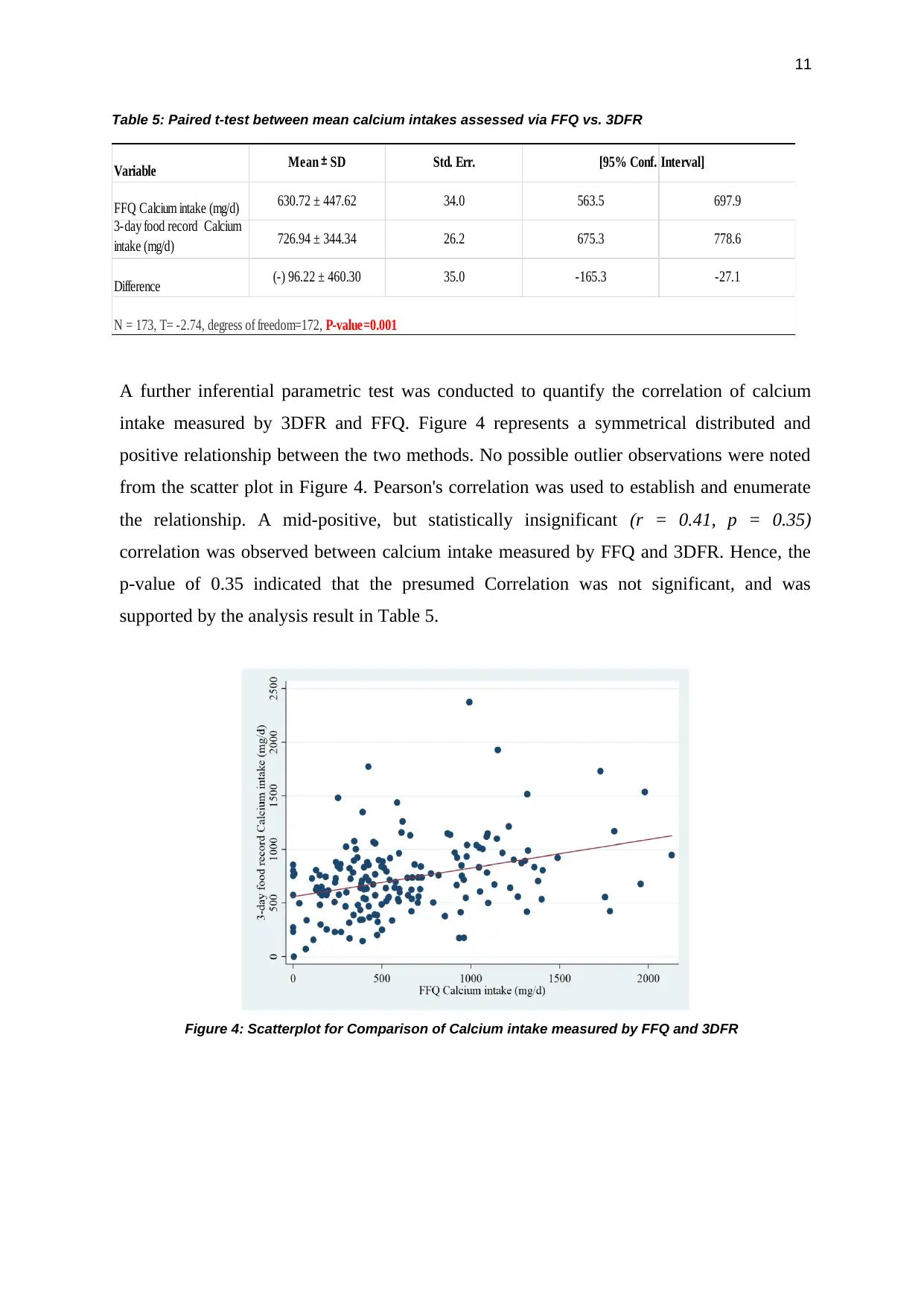
11
Table 5: Paired t-test between mean calcium intakes assessed via FFQ vs. 3DFR
Variable Mean ± SD Std. Err. [95% Conf. Interval]
FFQ Calcium intake (mg/d) 630.72 ± 447.62 34.0 563.5 697.9
3-day food record Calcium
intake (mg/d) 726.94 ± 344.34 26.2 675.3 778.6
Difference (-) 96.22 ± 460.30 35.0 -165.3 -27.1
N = 173, T= -2.74, degress of freedom=172, P-value=0.001
A further inferential parametric test was conducted to quantify the correlation of calcium
intake measured by 3DFR and FFQ. Figure 4 represents a symmetrical distributed and
positive relationship between the two methods. No possible outlier observations were noted
from the scatter plot in Figure 4. Pearson's correlation was used to establish and enumerate
the relationship. A mid-positive, but statistically insignificant (r = 0.41, p = 0.35)
correlation was observed between calcium intake measured by FFQ and 3DFR. Hence, the
p-value of 0.35 indicated that the presumed Correlation was not significant, and was
supported by the analysis result in Table 5.
Figure 4: Scatterplot for Comparison of Calcium intake measured by FFQ and 3DFR
Table 5: Paired t-test between mean calcium intakes assessed via FFQ vs. 3DFR
Variable Mean ± SD Std. Err. [95% Conf. Interval]
FFQ Calcium intake (mg/d) 630.72 ± 447.62 34.0 563.5 697.9
3-day food record Calcium
intake (mg/d) 726.94 ± 344.34 26.2 675.3 778.6
Difference (-) 96.22 ± 460.30 35.0 -165.3 -27.1
N = 173, T= -2.74, degress of freedom=172, P-value=0.001
A further inferential parametric test was conducted to quantify the correlation of calcium
intake measured by 3DFR and FFQ. Figure 4 represents a symmetrical distributed and
positive relationship between the two methods. No possible outlier observations were noted
from the scatter plot in Figure 4. Pearson's correlation was used to establish and enumerate
the relationship. A mid-positive, but statistically insignificant (r = 0.41, p = 0.35)
correlation was observed between calcium intake measured by FFQ and 3DFR. Hence, the
p-value of 0.35 indicated that the presumed Correlation was not significant, and was
supported by the analysis result in Table 5.
Figure 4: Scatterplot for Comparison of Calcium intake measured by FFQ and 3DFR
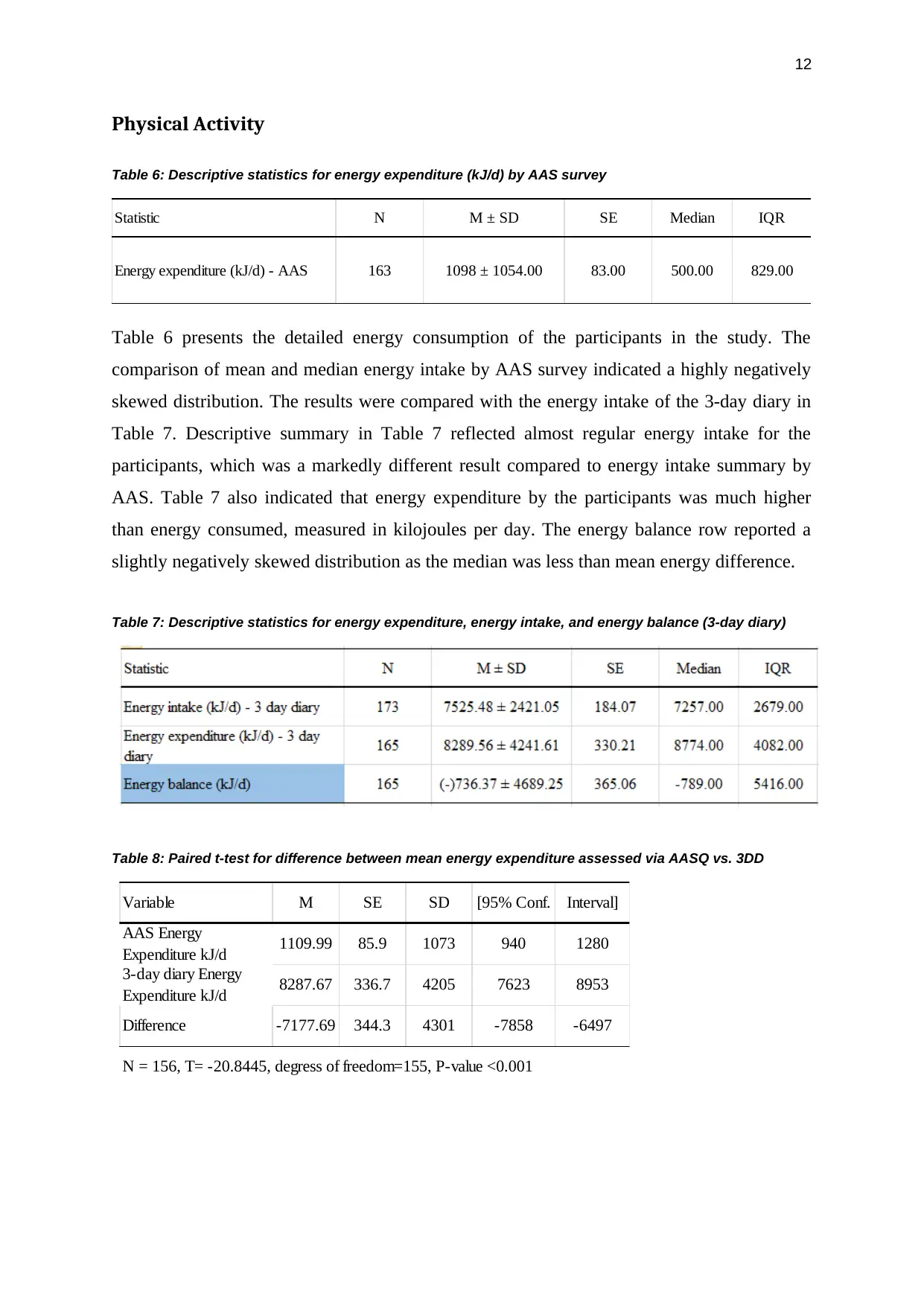
12
Physical Activity
Table 6: Descriptive statistics for energy expenditure (kJ/d) by AAS survey
Statistic N M ± SD SE Median IQR
Energy expenditure (kJ/d) - AAS 163 1098 ± 1054.00 83.00 500.00 829.00
Table 6 presents the detailed energy consumption of the participants in the study. The
comparison of mean and median energy intake by AAS survey indicated a highly negatively
skewed distribution. The results were compared with the energy intake of the 3-day diary in
Table 7. Descriptive summary in Table 7 reflected almost regular energy intake for the
participants, which was a markedly different result compared to energy intake summary by
AAS. Table 7 also indicated that energy expenditure by the participants was much higher
than energy consumed, measured in kilojoules per day. The energy balance row reported a
slightly negatively skewed distribution as the median was less than mean energy difference.
Table 7: Descriptive statistics for energy expenditure, energy intake, and energy balance (3-day diary)
Table 8: Paired t-test for difference between mean energy expenditure assessed via AASQ vs. 3DD
Variable M SE SD [95% Conf. Interval]
AAS Energy
Expenditure kJ/d 1109.99 85.9 1073 940 1280
3-day diary Energy
Expenditure kJ/d 8287.67 336.7 4205 7623 8953
Difference -7177.69 344.3 4301 -7858 -6497
N = 156, T= -20.8445, degress of freedom=155, P-value <0.001
Physical Activity
Table 6: Descriptive statistics for energy expenditure (kJ/d) by AAS survey
Statistic N M ± SD SE Median IQR
Energy expenditure (kJ/d) - AAS 163 1098 ± 1054.00 83.00 500.00 829.00
Table 6 presents the detailed energy consumption of the participants in the study. The
comparison of mean and median energy intake by AAS survey indicated a highly negatively
skewed distribution. The results were compared with the energy intake of the 3-day diary in
Table 7. Descriptive summary in Table 7 reflected almost regular energy intake for the
participants, which was a markedly different result compared to energy intake summary by
AAS. Table 7 also indicated that energy expenditure by the participants was much higher
than energy consumed, measured in kilojoules per day. The energy balance row reported a
slightly negatively skewed distribution as the median was less than mean energy difference.
Table 7: Descriptive statistics for energy expenditure, energy intake, and energy balance (3-day diary)
Table 8: Paired t-test for difference between mean energy expenditure assessed via AASQ vs. 3DD
Variable M SE SD [95% Conf. Interval]
AAS Energy
Expenditure kJ/d 1109.99 85.9 1073 940 1280
3-day diary Energy
Expenditure kJ/d 8287.67 336.7 4205 7623 8953
Difference -7177.69 344.3 4301 -7858 -6497
N = 156, T= -20.8445, degress of freedom=155, P-value <0.001
⊘ This is a preview!⊘
Do you want full access?
Subscribe today to unlock all pages.

Trusted by 1+ million students worldwide
1 out of 31
Related Documents
Your All-in-One AI-Powered Toolkit for Academic Success.
+13062052269
info@desklib.com
Available 24*7 on WhatsApp / Email
![[object Object]](/_next/static/media/star-bottom.7253800d.svg)
Unlock your academic potential
Copyright © 2020–2025 A2Z Services. All Rights Reserved. Developed and managed by ZUCOL.





